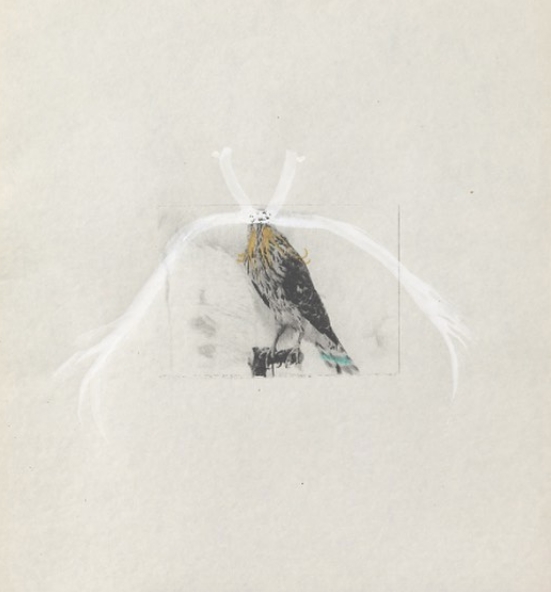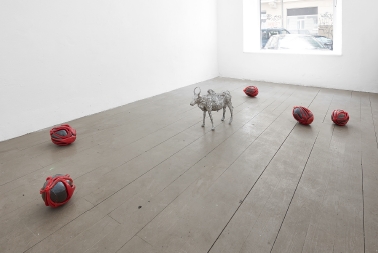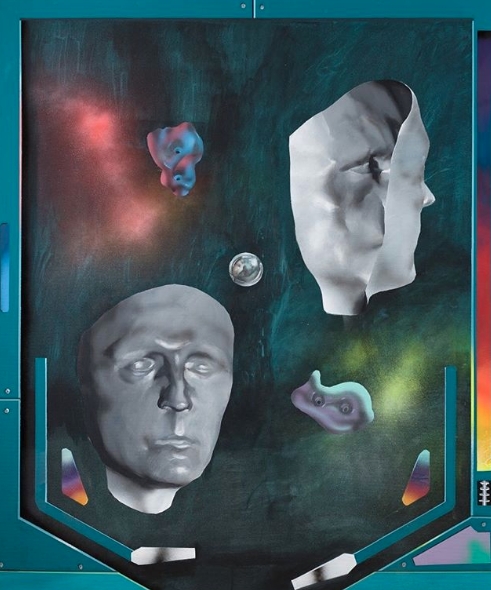
Friend of a Friend in its origin refers to Condo Complex held in London and various other cities since 2016. Condo was conceived and founded on the principle of friendly collaboration between galleries opposed to competition and the art market. The event establishes an innovative platform for contemporary art, an exchange model alternative to art fairs.
Friend of a Friend applies this same format to the city of Warsaw. Over the course of (how long will it run), eight contemporary art galleries–BWA Warszawa, Dawid Radziszewski, Foksal Gallery Foundation, LETO, Piktogram, Raster, Stereo, Wschód–will share their exhibition spaces with international guests. A dialogue between galleries from the Czech Republic, France, Germany, United States, Switzerland and Great Britain lies at the foundation of a series of group shows featuring Polish and international artists, forming the exhibition program of FOAF.
Adam Przywara: Piotr, Michał, as organizers of the event, tell me what is Friend of a Friend (FOAF) ?
Piotr Drewko: The historical reference for such events reaches deeper than, we tend to say, Condo Complex. About that in a moment, first description. FOAF is an event during which local galleries in Warsaw share their exhibition spaces with invited international galleries. Guest galleries bring their artists and exhibit their work along with the hosts artists. In this way several group exhibitions around Warsaw will open and crucial possibility of exchange between the guest and the host will emerge. As the official reference in our press releases, we always use Condo. However, this modes of cooperation between commercial galleries emerged much earlier. For example, in the United States in the 1990s, galleries exchanged their spaces for the holiday season. In Poland, Raster Gallery and its initiatives also could be recalled in this context.
Michał Lasota: Yes, in fact, Willa Warszawa, which happened already over 10 years ago (2006), could be understood as a similar event. With the crucial difference, that for the duration of its later editions, whether in Reykjavik or Tokyo, all participants were moving putting a city in the position of the host. Thinking, describing, and organising FOAF, we wanted to strongly underline and work through the relationship of hospitality, the relationship between guest and host.
AP: Condo as a format and as a brand is spreading to other cities, such as Sao Paulo and Mexico City. Why, then organize and launching Condo Warsaw ?
ML: This was, of course, our primary idea. In the beginning the plan was to join forces, Condo came a fruition thanks to the initiative of Vanessa Carlos (Carlos / Ishikawa Gallery). We have turned over the question about organizing such an event in Warsaw. However, she explained that the idea for her event, which she is trying to adhere to. Condo on one continent. So in Europe, it’s in London, in North America it’s in New York, Central America – Mexico City, South America – Sao Paulo. As far as Shanghai is concerned. Perhaps, this refusal is a product of us. Ultimately, I think it’s a good idea.



AP: Stereo Gallery and Dawid Radziszewski Gallery were already hosted in London by The Sunday Painter gallery during Condo.
ML: Yes, we were in London this and last year. With the gallery, we also visited a similar event under the name Okey-Dokey, organized in Dusseldorf.
AP: And how do you recall the experience of being a guest in London?
ML: I think that it was a significant experience in the context of preparation of such event on our own. It certainly shaped our thinking about how we would like to organize the whole thing. Usually, when you visit an event you can afford a dose of criticism and distance. It helps to determine what are the pros, and what are the cons of the entire initiative you look at. After visiting London, I had the impression that many elements could be improved. One of those elements that also differ FOAF from Condo is the cost of participation — it is free. In London, invited galleries had to pay for participation in the event. Although not much — about 650 pounds — but still. Apparently, this money goes to support the website and events. The website really does impress, but the event itself, for this money, could afford a bit more hospitality.
Next to the galleries and artists, the event will also consolidate a number of people directly connected with the art market and important European institutions.
AP: In Poland, instead of a fee, there is cooperation with Adam Mickiewicz Institute (IAM). The whole event is a public-private partnership.
PD: Yes, cooperation with IAM certainly helps resolving the financial struggles. We are very pleased about this cooperation, among others due to the fact that Institutes involvement largely improved all the organizational and infrastructural issues. At the same time, presence of this public body gives FOAF a desired international position. At the same time it fulfils ambitions of this public institution, by developing networks between international and Polish artistic community. IAMs program of art residencies is organised by Ewa Borysiewicz, and she is our partner from the institutions sine. Part of the art residencies budget was designated for the invitation to Warsaw of over 30 people from international art scene – curators, experts and collectors. Therefore, next to the galleries and artists, the event will also consolidate a number of people directly connected with the art market and important European institutions.
AP: Referring to the title of the event – are invited galleries real friends of yours? What was the process of choosing the guest galleries?
PD: The guest list was from the beginning designed by us – Wschód and Stereo – which imposed on the participants a clearly structured situation. Our international guests are galleries that take an active part in number of important art fairs around the globe. They also present an interesting and broad program, working not only with the artists they represent. These are, of course, quite extensive criteria burdened with our subjective decisions. However, in this “designed” situation, it was the only way to maintain a sufficiently sophisticated level of the program. The hosts here in Warsaw were selected and invited according to double criteria: international activity and a ambitious program of exhibitions with the participation of foreign artists. The list of these galleries is not permanent and can be modified in subsequent editions.
AP: As organizers of FOAF you selected and combined galleries. What influence did you have on the individual shows?
ML: That’s right. We took care of the selection of local and international galleries. Later, we also determined which gallery will host which of the guests. What made us happy, ultimately, apart from slight differences, is that each of the hosts accepted the guests we proposed. At this level, our curatorial function ended and we ourselves transform into the participants.
PD: This is also the fundamental difference between us and the Condo. We chose a top-down selection of partners that can produce interesting and unexpected results. Despite the exclusion of randomness, we try not to limit ourselves or anyone and in this way avoid predictable situations. This structure will stay as FOAF format. Unless I am wrong and we let the galleries invite their guests next year?
ML: No, no, there is definitely no such plans. We really care for the good results which can emerge from these combinations. Since the organization of the whole event costs us a lot of effort, we wanted to maintain maximum control so that we can be satisfied with the results ourselves. However, we kept a space for conversations and suggestions by the host gallery. We engaged with the individual discussions and allowed some degree of influence on the final pairings. If there was a suggestion of who on our list would be an interesting guest for one of the hosts, we agreed, but we did not invite to this process openly.
PD: Yes. This situation could be understood as slightly imposing, but thanks to that the whole event gains more ambitious and unpredictable character.


AP: So in each space participating in FOAF, we will find collective exhibitions of a host gallery joined by works of artists represented by two to three visiting galleries? Curatorial work on these group exhibitions is left to individual galleries?
ML: As a final effect, I would not expect any exhibitions with a strong curatorial concept. It will rather be a series of improvisations. The works brought by the visitors will rather refer to their programs, rather than some conceptual work made in collaboration with the host. With this in mind, what may come out as particularly interesting is a certain ambitious randomness of these combinations. In many cases, galleries and their artists will get to know each other for the first time.
AP: So we can say it is a blind date?
PD: Your guess is as good as mine. This is an arranged situation that to some extent interferes with host gallery programs and enforces certain restraint, while teaching relative openness and compromise. Warsaw galleries have no influence on what our foreign partners will bring. They have a freedom to work on how it will be presented in dialogue with their guests. There is a chance to work on a common language for the gallery owners and artists, which in other conditions would not have chance to emerge. It is about creating a common ground and basing it in communal exhibition making.
FOAF should be viewed not as an example of a counterpoint to current modes of production in the global art but rather as a natural need to build parallel modalities.
AP: Friend of a Friend also announced cooperation with the Friends of the Museum of Modern Art in Warsaw.
ML: Yes, we are very happy about it. Friends of the Museum, a group of donors supporting the institution, willingly agreed to fund the prize that will be granted during the event. The selected jury will choose the work presented as part of FOAF. The selected work will be purchased by the newly established The Friends Art Fund and donated to the MoMA Warsaw collection. This is another thing that we learned when traveling around other events like ours. Commercial or less commercial events should introduce various types of possible gratification for their participants. This makes the whole thing more attractive and enjoyable. And it is not about competition between participants. It is rather difficult to imagine such competition between artists. It’s supposed to be a cherry on the cake of your visit in Warsaw.
PD: This is an example of a successful cooperation between the most important public art institution in Poland and the rest of the art world – galleries, commercial entities, curators and critics. It is all crucial to our broader aims. Such a gesture can enrich the public collection with works that escape a specific, more or less fixed purchasing line, which is also burdened with specific procedural rules. The work which would be an outcome of Friend of a Friend price, to some extent will be a divergent element in the Museum’s collection.
AP: So the international galleries that agreed to visit Warsaw can count on winning the prize for their artists?
ML: Yes, we hope that this award gives such an outcome. It would be desirable that an international gallery wins the prize. It would grant us good perspectives towards next editions of the event. We would like the news to spread. News that participation in this event is also a great opportunity for artists to become a part of the collection of Warsaw’s Museum of Modern Art.
AP: Looking at the Friend of a Friend in a broader context, we could say that this event is an initiative aiming to create alternative models for small and medium-sized galleries. Instead of “competition”, you work on the notions of “hospitality” and “cooperation”. It is somehow an answer for our difficult times. As reported recently in the New York Times, small and medium commercial galleries are being squeezed in the market by giants like Hauser & Wirth and David Zwirner.
ML: Yes, the problem of functioning as a small or medium galleries concerns us. It is our problem in the end. Indeed, I saw several articles like this appear. And I actually stopped reading them because I realized that I knew about it from the very beginning. Working on this scale generates a number of problems and requires a huge amount of determination. However, referring to the notion you mentioned – “competition” – I think that it’s not an appropriate one. Fundamentally, galleries compete with each other in a very different way, it is not as in sport or a stock market game. We always assume that intellectual or commercial interest in one artist is not related to the lack of interest in another. Hospitality and cooperation is on the other hand quite on point.
PD: Also because we all can benefit from what can be built around art. It is creating symbolic capital, networks and relations facilitating an international exchange. The moment of transaction which can sustain a gallery is the result of all these factors. International cooperation raises awareness, strengthens the position and enriches the local and national art field. FOAF should be viewed not as an example of a counterpoint to current modes of production in the global art but rather as a natural need to build parallel modalities.
ML: That’s what it was from Condo in London. For me, it was striking for the hosts. On the other hand, as a guest I had a sense of dissatisfaction. I would like Friend of a Friend to be a guest of London experience. My ambitions are to show the infamous eastern hospitality.
